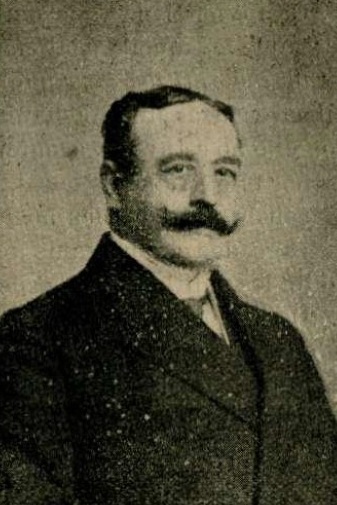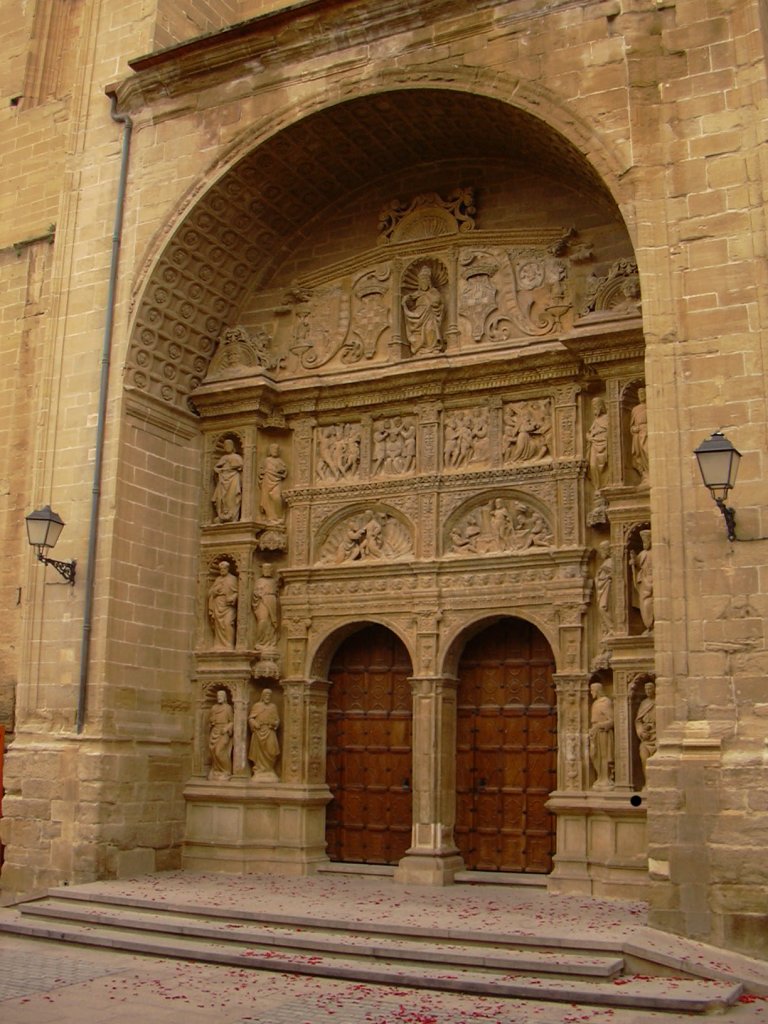|
Tomás Domínguez Arévalo
Tomás Domínguez Arévalo, 6th Count of Rodezno, 12th Marquis of San Martin (1882–1952) was a Spanish Carlist and Francoist politician. He is known mostly as the first Francoist Minister of Justice (1938–1939). He is also recognised for his key role in negotiating Carlist access to the coup of July 1936 and in emergence of carlo-francoism, the branch of Carlism which actively engaged in the Francoist regime. Family and youth Tomás Domínguez y de Arévalo Romera y Fernández Navarrete was a descendant of two landowner families from the very south and from the very north of Spain. The paternal Domínguez family has been for centuries related to the Andalusian town of Carmona (Seville province). Its first representatives were noted as regidores in the 18th century and intermarried with another distinguished local family, the Romeras. Their descendant was Tomás' father, Tomás Domínguez Romera (1848–1931), who inherited the local Campo de la Plata estate. He demonstra ... [...More Info...] [...Related Items...] OR: [Wikipedia] [Google] [Baidu] |
The Most Excellent
The Most Excellent (Spanish language, Spanish: ''Excelentísimo Señor'' (male) or ''Excelentísima Señora'' (female), literally "Most Excellent Sir/Madam") is an honorific prefix that is traditionally applied to certain people in Spain and certain Spanish-speaking countries. Following Spanish tradition, it is an ''ex officio'' style (the holder has it as long as they remain in office, in the most important positions of state) and is used in written documents and very formal occasions. The prefix is similar (but not equal) to that of "Excellency, His/Her Excellency", but in the 19th century "The Most Excellent" began to replace the former. The use of the prefix Excellency was re-introduced in Francoist Spain by ''Generalísimo'' Francisco Franco himself, who was formally styled as ''Military career and honours of Francisco Franco, Su Excelencia el Jefe del Estado'' ("His Excellency The Head of State"), while his ministers and senior government officials continued using the prefix ... [...More Info...] [...Related Items...] OR: [Wikipedia] [Google] [Baidu] |
La Rioja (Spain)
La Rioja () is an autonomous community and province in Spain, in the north of the Iberian Peninsula. Its capital is Logroño. Other cities and towns in the province include Calahorra, Arnedo, Alfaro, Haro, Santo Domingo de la Calzada, and Nájera. It has an estimated population of 315,675 inhabitants (INE 2018), making it the least populated autonomous community of Spain. It covers part of the Ebro valley towards its north and the Iberian Range in the south. The community is a single province, so there is no County Council, and it is organized into 174 municipalities. It borders the Basque Country (province of Álava) to the north, Navarre to the northeast, Aragón to the southeast (province of Zaragoza), and Castilla y León to the west and south (provinces of Burgos and Soria). The area was once occupied by pre-Roman Berones, Pellendones and Vascones. After partial recapture from the Muslims in the early tenth century, the region became part of the Kingdom of Pamplona, l ... [...More Info...] [...Related Items...] OR: [Wikipedia] [Google] [Baidu] |
Matías Barrio Y Mier
Matías Barrio y Mier (1844–1909) was a Spanish law academic and a Carlist politician. He served as a scholar of jurisprudence at various universities, though mostly in Oviedo (1881-1892) and Madrid (1892-1909), and authored manuals used by students until the 1930s. He is best known, however, as the Carlist political leader (1899-1909). As a Traditionalist he served 9 terms in the Cortes, initially during the rule of Amadeo I (1871-1872) and then during the Restoration period (1891-1903, 1905-1909). Family and youth Matías Barrio y Mier was born in a mountainous village of Verdeña (Province of Palencia). His paternal grandparents, Manuel Barrio and Teresa Vielba, were local hidalgos. His maternal grandparents, Simon Morante and Tomasa de Mier, belonged to petty nobility from the nearby San Juan de Redondo. His father José Barrio Vielba married Dolores de Mier y Terán; the couple had no children. Following her premature death, in 1836 Barrio Vielba married the niece of h ... [...More Info...] [...Related Items...] OR: [Wikipedia] [Google] [Baidu] |
Jesuit
, image = Ihs-logo.svg , image_size = 175px , caption = ChristogramOfficial seal of the Jesuits , abbreviation = SJ , nickname = Jesuits , formation = , founders = , founding_location = , type = Order of clerics regular of pontifical right (for men) , headquarters = Generalate:Borgo S. Spirito 4, 00195 Roma-Prati, Italy , coords = , region_served = Worldwide , num_members = 14,839 members (includes 10,721 priests) as of 2020 , leader_title = Motto , leader_name = la, Ad Majorem Dei GloriamEnglish: ''For the Greater Glory of God'' , leader_title2 = Superior General , leader_name2 = Fr. Arturo Sosa, SJ , leader_title3 = Patron saints , leader_name3 = , leader_title4 = Ministry , leader_name4 = Missionary, educational, literary works , main_organ = La Civiltà Cattolica ... [...More Info...] [...Related Items...] OR: [Wikipedia] [Google] [Baidu] |
María De Arévalo Y Fernandez De Navarrete
Maria may refer to: People * Mary, mother of Jesus * Maria (given name), a popular given name in many languages Place names Extraterrestrial *170 Maria, a Main belt S-type asteroid discovered in 1877 *Lunar maria (plural of ''mare''), large, dark basaltic plains on Earth's Moon Terrestrial *Maria, Maevatanana, Madagascar *Maria, Quebec, Canada *Maria, Siquijor, the Philippines *María, Spain, in Andalusia *Îles Maria, French Polynesia *María de Huerva, Aragon, Spain *Villa Maria (other) Arts, entertainment, and media Films * ''Maria'' (1947 film), Swedish film * ''Maria'' (1975 film), Swedish film * ''Maria'' (2003 film), Romanian film * ''Maria'' (2019 film), Filipino film * ''Maria'' (2021 film), Canadian film directed by Alec Pronovost * ''Maria'' (Sinhala film), Sri Lankan upcoming film Literature * ''María'' (novel), an 1867 novel by Jorge Isaacs * ''Maria'' (Ukrainian novel), a 1934 novel by the Ukrainian writer Ulas Samchuk * ''Maria'' (play), a 1935 play b ... [...More Info...] [...Related Items...] OR: [Wikipedia] [Google] [Baidu] |
Juan Vázquez De Mella
Juan Vázquez de Mella y Fanjul (1861–1928) was a Spanish politician and a political theorist. He is counted among the greatest Traditionalist thinkers, at times considered the finest author of Spanish Traditionalism of all time. A politician active within Carlism, he served as a longtime Cortes deputy and one of the party leaders. He championed an own political strategy, known as Mellismo, which led to secession and formation of a separate grouping. Family and youth Juan Antonio María Casto Francisco de Sales Vázquez de Mella y Fanjul was descendant to an old, though not particularly distinguished Galician family; its best known representative was a 15th-century-cardinal of Zamora. There were mostly military men among Juan's ancestors along the paternal line, related to various towns in Galicia; military were also his grandfather, Andrés Vázquez de Mella, a native of Filgueira, and his father, Juan Antonio Vázquez de Mella y Várela (died 1874), born in Boimorto. The ... [...More Info...] [...Related Items...] OR: [Wikipedia] [Google] [Baidu] |
Enrique De Aguilera Y Gamboa
Enrique de Aguilera y Gamboa, 17th Marquess of Cerralbo (1845 – 1922), was a Spanish archaeologist and a Carlist politician. Family and youth Enrique de Aguilera y Gamboa came from the aristocratic family for centuries residing in the Salamanca province; his ancestors can be traced back to the 14th century, and it was in 1533 when his forefather was named marquis by Carlos I. His father, Francisco de Asís de Aguilera y Becerril, was the founder and director of the ''Gimnasio Real de Madrid'' (Casón del Buen Retiro) and became known as a promoter of physical exercises, supported with a number of machines he invented himself. Married to María Luisa de Gamboa y López de León, the couple had 13 children. Enrique was first educated at the Madrid Colegio de las Escuelas Pías de San Fernando, later on to study Philosophy and Letters and Law at the Universidad Central. With the death of his father in 1867, Enrique as the oldest living son acquired the conde de Villalobos titl ... [...More Info...] [...Related Items...] OR: [Wikipedia] [Google] [Baidu] |
New Castile (Spain)
New Castile ( ) is a historic region of Spain. It roughly corresponds to the historic Moorish Taifa of Toledo, taken during the ''Reconquista'' of the peninsula by Christians and thus becoming the southern part of Castile. The extension of New Castile was formally defined after the 1833 territorial division of Spain as the sum of the following provinces: Ciudad Real, Cuenca, Guadalajara, Madrid and Toledo. Key to the reconquest of New Castile were the capture of Toledo in 1085, ending the Taifa's Kingdom of Toledo, and the Battle of Las Navas de Tolosa in 1212. It continued to be called the Kingdom of Toledo when it was in the Crown of Castile. Then, it started to be called New Castile in the 18th century. ''New Castile'' is separated from ''Old Castile'' to the north by the Sistema Central range of mountains. In the current territorial division of Spain, it covers the autonomous communities of Madrid and Castile–La Mancha (which also includes Albacete). See also *Cas ... [...More Info...] [...Related Items...] OR: [Wikipedia] [Google] [Baidu] |
Agoitz
Agoitz, or Spanish Aoiz, is a town and municipality located in the province and autonomous community of Navarre, northern Spain , image_flag = Bandera de España.svg , image_coat = Escudo de España (mazonado).svg , national_motto = ''Plus ultra'' (Latin)(English: "Further Beyond") , national_anthem = (English: "Royal March") , i .... References External linksAyuntamiento de Aoiz - AgoitzAOIZ - AGOITZ in the Bernardo Estornés Lasa - Auñamendi Encyclopedia (Euskomedia Fundazioa) Municipalities in Navarre {{navarre-geo-stub ... [...More Info...] [...Related Items...] OR: [Wikipedia] [Google] [Baidu] |
Logroño (province)
La Rioja () is an autonomous community and province in Spain, in the north of the Iberian Peninsula. Its capital is Logroño. Other cities and towns in the province include Calahorra, Arnedo, Alfaro, Haro, Santo Domingo de la Calzada, and Nájera. It has an estimated population of 315,675 inhabitants (INE 2018), making it the least populated autonomous community of Spain. It covers part of the Ebro valley towards its north and the Iberian Range in the south. The community is a single province, so there is no County Council, and it is organized into 174 municipalities. It borders the Basque Country (province of Álava) to the north, Navarre to the northeast, Aragón to the southeast (province of Zaragoza), and Castilla y León to the west and south (provinces of Burgos and Soria). The area was once occupied by pre-Roman Berones, Pellendones and Vascones. After partial recapture from the Muslims in the early tenth century, the region became part of the Kingdom of Pamplona, lat ... [...More Info...] [...Related Items...] OR: [Wikipedia] [Google] [Baidu] |
Haro, La Rioja
Haro () is a town and municipality in the northwest of La Rioja province in northern Spain. It produces red wine, and hosts the annual Haro Wine Festival. Its architectural heritage includes the plateresque main entrance of the Church of Santo Tomás, the work of Felipe Vigarny, numerous palaces, and the old town, which was declared a Historic-Artistic Site in 1975. Haro was the first town in Spain to have electric street lighting. History There are several theories about the founding of Haro, though the most realistic theory is that of Domingo Hergueta, who argued that before the town, there was a lighthouse ( es, faro) near the village of Cerro de la Mota which illuminated the mouth of the Ebro river. The town was named for the lighthouse, and ''Faro'' later evolved into ''Haro''. During the Roman rule of Hispania, a fort called Castrum Bibilium was built in the cliffs of Bibilio. The first mention of Haro dates back to the year 1040, in a document of king García Sánchez I ... [...More Info...] [...Related Items...] OR: [Wikipedia] [Google] [Baidu] |






